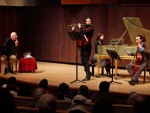Title
William Christie returned to Juilliard for his third annual residency and master class on March 31. In President Joseph Polisi’s opening remarks, he referred to Christie as “the godfather of early music at Juilliard” and said that as soon as Juilliard became interested in forming a Historical Performance program, Christie was the first name that came to mind to have involved. In a departure from the standard master class approach, Christie took the opportunity to give the audience a primer on the issues involved in historical performance practice.
Body
The first performers were violinist Liv Heym and harpsichordist Jeff Grossman on the Seventh Concert from Francois Couperin’s Les goûts-réünis. After a full performance of the work, Christie took a moment to place it in its historical context. Of particular importance was the period in which it was composed—at the end of the reign of Louis XIV. Christie felt that the piece had “an extraordinary melancholy” that reflected the status of the king at the end of a long reign. Musically, Christie used this performance to demonstrate how much of historical performance is based on playing beyond what is on the page. He said the music required “a different breed from your garden variety conservatory student. You’ve got to become a specialist such that you can nourish, develop, and fully flesh out the score.” He specifically focused on the ornaments. Relating them to French grammar, he emphasized the role of ornaments in highlighting dissonance and therefore stressed and unstressed syllables. The understanding of this is critical, according to Christie, in allowing the music to become eloquent.
Next was oboist Priscilla Smith with cellist Ezra Seltzer and Grossman back on harpsichord, performing a Telemann partita. Again, Christie noted Telemann’s place in history as the most cosmopolitan composer of his era and humorously mentioned that the facsimile being used for the performance appeared to be a “homespun engraving copied by Grandma on a Sunday afternoon.” With Smith’s performance, Christie took the opportunity to comment on the use of period instruments and commended the courage it took to switch to a period instrument after developing skills on its modern counterpart. He also said, “It’s amongst the winds that this courage must be doubly strong—it’s essentially a completely different instrument.” Relating it to the old argument that if Bach had had a piano, he would have used it instead of harpsichord, Christie feels that Bach would have written his music differently had he been writing for piano. As it stands, it is better suited to the historical instruments. “The instruments were created to serve a particular repertoire, and they serve it better than anything else,” he said.
The discussion of period instruments, manuscript sources, and French style continued with Emi Ferguson, flute, Andrew Arceci, viola da gamba, and Aya Hamada, harpsichord, performing a Hotteterre suite. Ferguson, formerly an undergraduate in modern flute at Juilliard, was involved in previous master classes with Christie, a fact which Christie recalled with great pleasure. Musically, Christie pointed out the use of “notes inégales,” that is, the performance of music notated in equal rhythmic values in an unequal way. Like the ornaments in the Couperin suite, Christie felt this reflected vocal music and the French way of speaking with long and short, stressed and unstressed syllables. He emphasized the subtlety of this performance practice and how impossible it would be to notate, though it is well documented by countless theoreticians and musicians of the era. Another interesting discussion that grew out of this performance returned to the use of historical instruments and reconstructions. Ferguson and Christie both reveled in the notion that Hotteterre was not only a composer but also a flute maker and the music was thereby being performed on precisely the resources and sound palette that Hotteterre had written it for.
To conclude the class, a Purcell sonata was performed by Heym, violinist Beth Wenstrom, cellist Beiliang Zhu, and Hamada on harpsichord. This was a preview of one of the pieces that would be on the concert with Christie at Alice Tully Hall a few days later. For historical context, Christie quoted Purcell as saying, “I use Italian music for its brilliance and French music for its grace.” Christie was especially fond of this music and mentioned, “If I were to choose a piece that I would take off to my desert island, it would be this one.” He also described the piece in a wonderfully vibrant way, calling it a “monument to seductive intelligence” and “music for the connoisseur.” He was so pleased with the performance that he offered what he called the greatest praise he could—that he felt nothing in it needed to be changed!
Throughout the master class, Christie continually highlighted the need for specialists to focus on the music of the Baroque. He is clearly a passionate specialist, but it was the constant delight and joy with which he approached the music that made him so inspiring.





